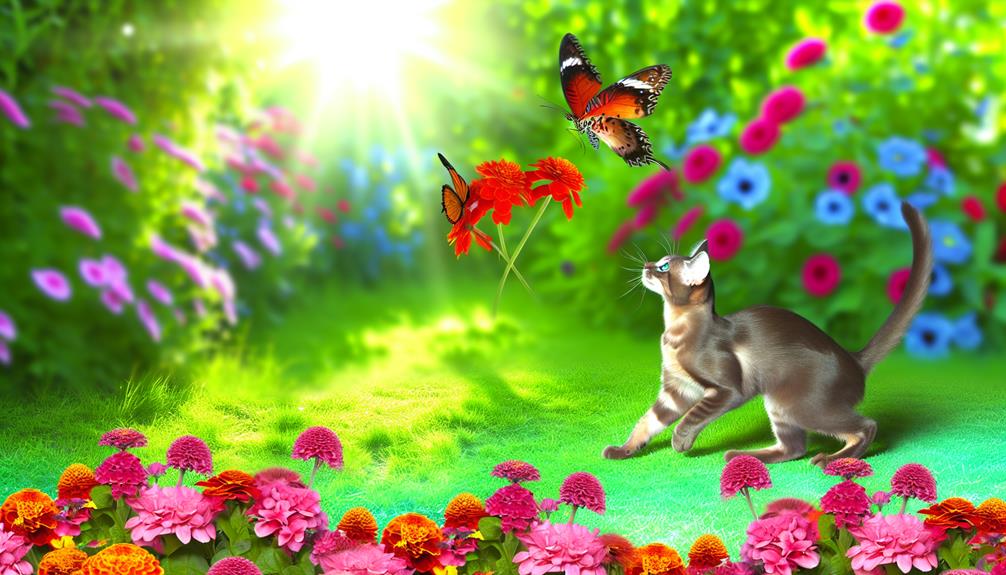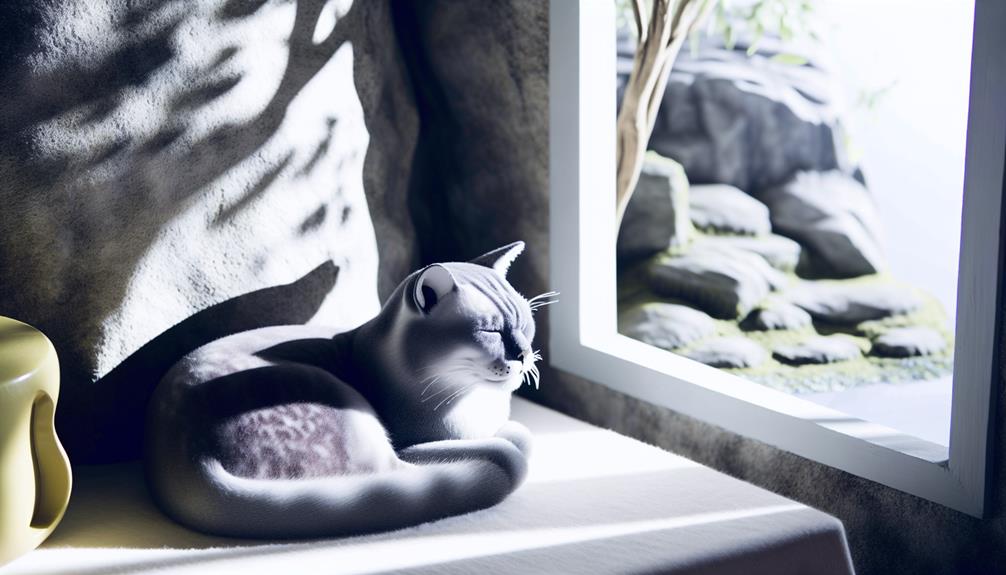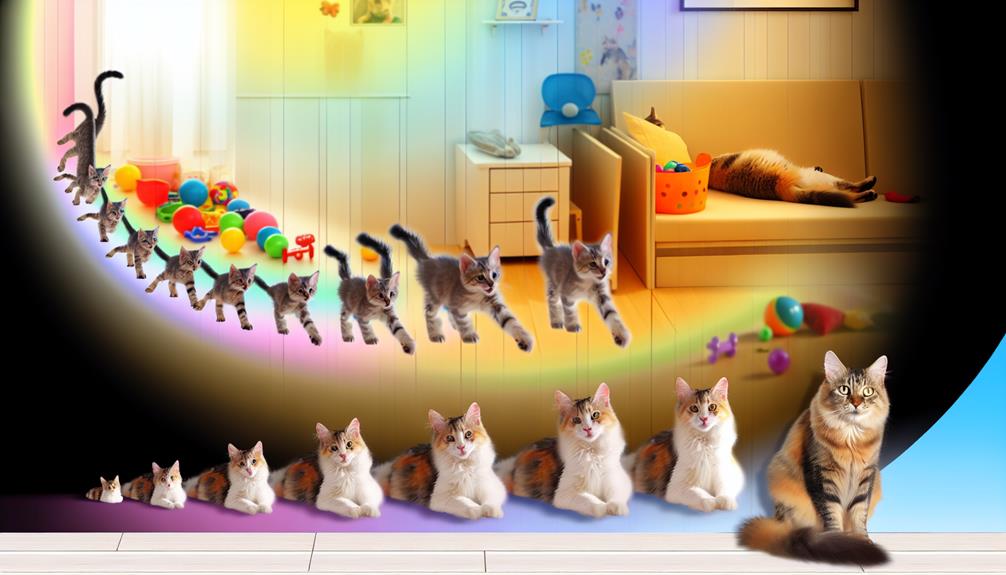You might not know that a cat's aging process is quite different from a human's, with each life stage presenting unique needs and challenges. From the rapid development and socialization required during kittenhood to the special care needed in their geriatric years, understanding these stages can greatly impact your feline friend's quality of life. Curious about how to provide the best care at each stage? Let's explore what you can do to guarantee your cat ages gracefully and healthily.
Kittenhood: Birth to 6 Months
During kittenhood, which spans from birth to six months, a cat undergoes significant physiological and developmental changes. It's a vital period marked by rapid growth, cognitive development, and substantial shifts in behavior patterns. In the first few weeks, kittens are entirely dependent on their mother for nourishment and warmth. By the second week, their eyes and ears begin to open, allowing them to start exploring their environment.
Kitten behavior during this stage is profoundly shaped by early socialization. By three to four weeks, kittens start to exhibit play behavior, which is fundamental for developing motor skills and social competence. Interaction with littermates facilitates the learning of bite inhibition and the establishment of social hierarchies. If you expose kittens to various stimuli—such as different people, sounds, and textures—during this period, it can lead to well-adjusted adult cats. Studies have shown that kittens who experience positive socialization are less likely to develop behavioral issues later in life.
By six to eight weeks, kittens are usually weaned and begin to eat solid food. They become more independent and their exploratory behavior intensifies. This stage is ideal for introducing basic training, such as litter box use and scratching post training. Positive reinforcement techniques can be highly effective during this stage, as kittens are particularly receptive to learning new behaviors.
From a clinical perspective, regular veterinary check-ups are essential during kittenhood. Vaccinations, deworming, and early detection of congenital issues guarantee a healthy start. Understanding this vital developmental phase can help you provide the necessary care and socialization, setting the foundation for a well-adjusted adult cat.
Junior Cats: 6 Months to 2 Years
Shifting into the junior stage, which spans from six months to two years, cats continue to develop both physically and behaviorally, albeit at a slower pace compared to kittenhood. During this period, you'll observe notable changes in playful behavior and energy levels. While still highly active, junior cats start to exhibit more refined motor skills and an increased capacity for complex social interactions.
To guarantee best development, consider these evidence-based guidelines:
- Playful Behavior: Engage your cat in interactive play sessions to stimulate their mental and physical faculties. Use toys that mimic prey to satisfy their predatory instincts.
- Energy Levels: Junior cats maintain high energy levels, necessitating ample opportunities for exercise. A mix of climbing structures and interactive toys can help expend their energy.
- Social Interactions: This stage is vital for honing social skills. Encourage positive interactions with both humans and other pets to foster well-rounded social behavior.
- Training Tips: Junior cats are highly receptive to training. Utilize positive reinforcement techniques to teach essential commands and behaviors, such as using a scratching post or responding to their name.
- Grooming Needs: Regular grooming is important to prevent hairballs and skin issues. Brush your cat's coat frequently and pay attention to their dental hygiene.
Exploring environments is another significant aspect of this developmental phase. Provide a safe and stimulating environment that allows your cat to explore different textures, heights, and hiding spots. This not only satisfies their curiosity but also aids in their physical and cognitive growth.
Prime Years: 3 to 6 Years

The prime years, spanning from three to six years, mark a period of peak health and energy for cats. During this phase, a cat's physical and cognitive faculties are typically at their zenith. You'll observe that playful behavior often intensifies, as cats in this age range exhibit a high degree of agility and coordination. This is also the period when muscle tone and overall body condition are ideal, contributing to enhanced athleticism and endurance.
Clinically, cats in their prime years are less susceptible to age-related diseases, provided they receive regular veterinary care. Vaccinations, dental check-ups, and routine screenings for common feline diseases such as feline immunodeficiency virus (FIV) and feline leukemia virus (FeLV) are essential. By maintaining a preventive healthcare regimen, you can help mitigate any underlying conditions that might compromise their health.
Social interactions also reach a significant peak during these years. Cats are generally more sociable and interactive with both humans and other pets. This enhanced social behavior is evidence-based, as studies show that cats in their prime years display increased engagement in activities such as grooming, playing, and even more complex social dynamics like hierarchy establishment within multi-cat households.
Nutritionally, it's imperative to provide a balanced diet tailored to support their high energy levels and ideal weight maintenance. Incorporating high-quality protein and essential nutrients can maximize their health benefits. Monitoring their diet helps in preventing obesity, a common issue that could lead to other health complications.
Mature Cats: 7 to 10 Years
As your cat enters the mature stage of 7 to 10 years, you'll need to prioritize routine health monitoring to detect any early signs of chronic conditions. Dietary adjustments become essential to manage weight and support joint health, which are common concerns during this period. Evidence suggests that tailored nutrition and regular veterinary check-ups can notably improve their quality of life.
Health Monitoring Needs
Beyond the age of seven, cats enter a stage of maturity that demands increased attention to their health monitoring needs. To guarantee your cat's well-being, regular veterinary check-ups become essential. These assessments facilitate early detection of potential health issues and enable timely interventions. Observing and documenting behavior changes can provide valuable insights into your cat's health status.
Incorporate preventive care measures to stave off common ailments that mature cats face. Effective weight management is vital, as obesity can exacerbate conditions like diabetes and arthritis. Dental health shouldn't be overlooked; periodontal disease is prevalent in older cats and requires routine professional cleaning and at-home care.
To maintain physical fitness, establish consistent exercise routines. Structured playtime and interactive toys can help keep your cat agile. Environmental enrichment and mental stimulation are paramount to prevent cognitive decline and guarantee overall mental well-being.
- Regular veterinary check-ups for early detection and preventive care.
- Monitor and record behavior changes for clinical evaluation.
- Implement weight management strategies to avoid obesity.
- Prioritize dental health with regular cleanings and at-home care.
- Maintain exercise routines and provide environmental enrichment for mental stimulation.
Dietary Adjustments Required
Many mature cats, ranging from 7 to 10 years old, require specific dietary adjustments to address their evolving nutritional needs. As cats age, their metabolism slows down, necessitating a diet that's lower in calories but rich in essential nutrients. Age appropriate nutrition is crucial to maintaining peak health and preventing age-related conditions.
First, consider the protein content. Mature cats need high-quality protein to support muscle maintenance and overall well-being. Veterinary guidelines recommend feeding a diet with a balanced amino acid profile. Additionally, incorporating dietary supplements such as omega-3 fatty acids can help mitigate inflammation and support joint health.
Fiber is another important component. Increased fiber aids in gastrointestinal motility and helps manage weight, a common concern in aging felines. Look for cat foods specifically formulated for mature cats, which often include added fiber.
Moreover, antioxidants like vitamin E and beta-carotene are beneficial for immune support. These can be found in age-appropriate commercial diets or added as dietary supplements under veterinary guidance.
Lastly, guarantee adequate hydration by providing wet food or encouraging water intake. Dehydration can exacerbate kidney issues, which are prevalent in older cats. Regular veterinary check-ups will help tailor these dietary adjustments to your cat's individual health needs.
Senior Cats: 11 to 14 Years

Senior cats, aged 11 to 14 years, often exhibit noticeable changes in behavior and health. These senior behavior changes and aging signs are clinically significant and can be indicative of underlying medical conditions. As your cat ages into this senior stage, you'll observe shifts in their physical and mental well-being.
From a clinical perspective, several key indicators may signal the shift into senior status:
- Reduced Mobility: Arthritis and joint stiffness are common, leading to decreased activity levels.
- Cognitive Dysfunction: Similar to dementia in humans, cognitive decline can manifest as disorientation or altered interaction patterns.
- Altered Sleep Patterns: Increased sleep duration or changes in sleep-wake cycles are frequently observed.
- Weight Fluctuations: Both weight loss and gain can occur, often linked to metabolic changes or underlying disease.
- Dental Issues: Periodontal disease becomes more prevalent, impacting overall health and eating habits.
Evidence-based studies highlight the importance of regular veterinary check-ups to monitor these aging signs. Routine blood panels, urinalysis, and dental examinations are essential for early detection and management of age-related diseases such as chronic kidney disease, hyperthyroidism, and diabetes mellitus. Implementing a diet tailored to your senior cat's specific needs, enriched with joint supplements and antioxidants, can mitigate some of these senior behavior changes.
It's essential to modify the home environment to accommodate your senior cat's declining physical abilities. Providing easily accessible litter boxes, ramps, and orthopedic bedding can enhance their comfort. Additionally, mental stimulation through interactive toys and puzzle feeders can help maintain cognitive function.
Geriatric Cats: 15 Years and Older
When your cat reaches 15 years or older, you'll need to be vigilant about common geriatric health issues such as chronic kidney disease, arthritis, and dental problems. Evidence-based care for senior cats includes regular veterinary check-ups, specialized diets, and modifications to their environment to guarantee comfort and mobility. Implementing these clinical recommendations can greatly enhance your cat's quality of life.
Common Health Issues
As your cat reaches the geriatric stage, which is typically around 15 years and older, you'll likely encounter a range of common health issues. Clinical evidence underscores the significance of monitoring dental health, as age-related periodontal disease can exacerbate systemic conditions. Obesity management becomes vital; excess weight can lead to exacerbated arthritis and heart conditions. Renal function should be regularly assessed due to the high prevalence of chronic kidney disease in older felines. Arthritis prevention strategies, including weight control and joint supplements, can mitigate mobility issues.
Vision impairment and hearing loss are also common, necessitating environmental adjustments. Behavioral changes may indicate underlying health problems, such as hyperthyroidism or cognitive dysfunction. Thorough vaccination needs must be tailored to an aging immune system, balancing efficacy and safety.
Key health issues to monitor include:
- Dental care: Regular professional cleaning and at-home maintenance.
- Kidney disease: Routine blood tests and specialized diets.
- Heart conditions: Monitoring for signs of cardiomyopathy or hypertension.
- Arthritis: Anti-inflammatory medications and joint supplements.
- Skin issues: Regular checks for lumps, sores, or dermatitis.
Addressing these issues proactively can enhance your cat's quality of life and longevity.
Senior Cat Care
Caring for geriatric cats involves specialized attention to their unique needs, which differ markedly from younger counterparts. Regular veterinary check-ups become essential, allowing early detection of chronic ailments. Adjust grooming techniques to accommodate for thinning fur and reduced flexibility, guaranteeing ideal coat and skin health.
Environmental enrichment is vital; introduce safe, low-impact activities to promote physical and mental stimulation. Mobility aids, like ramps and orthopedic beds, can alleviate joint stress and enhance comfort zones. Hydration needs increase with age, so make sure water sources are easily accessible and consider wet food to supplement fluid intake.
Socialization strategies should be gentle, fostering positive interactions without overwhelming the cat. Monitor their behavior closely for signs of distress or discomfort. Palliative care may be necessary for managing pain or chronic conditions, focusing on maintaining quality of life.
As end of life decisions become more pertinent, consult with your veterinarian to understand all options and guarantee humane, compassionate care. Prioritize creating a serene environment, minimizing stress factors, and providing consistent, loving attention. Addressing these multifaceted needs holistically guarantees your senior cat's twilight years are as comfortable and fulfilling as possible.
Conclusion
Coincidentally, as you observe your cat maneuvering through these developmental stages, you'll notice their needs shift remarkably. From the rapid growth in kittenhood to the tailored care in geriatric years, each phase demands specific attention. Clinical evidence underscores the importance of adaptive care strategies, ensuring your feline's well-being. Regular veterinary visits, appropriate diet, and mental stimulation at each stage aren't just recommended—they're essential. By understanding these age-related changes, you're better equipped to optimize your cat's health and longevity.
